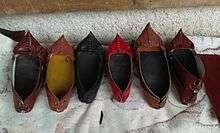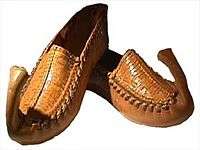Opanak


Opanak (Bulgarian: цървул, опинок[a]; Macedonian: опинок; Serbian Cyrillic: опанак) are traditional peasant shoes worn in Southeastern Europe (specifically Bosnia and Herzegovina, Bulgaria, Croatia, Macedonia, Serbia). The attributes of the Opanci (name in plural) are: a construction of leather, lack of laces, durable, and various ending on toes. In Serbia, the design of the horn-like ending on toes indicates the region of origin. The concept, and the word, exists in Romania (as opincă) which is borrowed from Slavic. The Opanci are considered a national symbol of Serbia, and the traditional peasant footwear for people in the Balkan region.
Etymology
Serbo-Croatian òpanak/о̀панак, as well as Bulgarian and Macedonian опинок, ultimately derive from Proto-Slavic word *opьnъkъ.[1] Proto-Slavic *opьnъkъ is composed from the following parts:[1]
- the preposition/prefix *o(b)- "around, on, etc." with final *b assimilated and the resulting geminated consonant cluster *pp simplified to *p
- *-pьn-, yielding Serbo-Croatian -pan- with strong jer *ь vocalized to /a/. *pьn- is the ablaut form of the root of the verb *pęti (from earlier *pen-ti), originally meaning "to strain, move" (cf. modern standard Serbo-Croatian verbs conveying the same notion such as nàpēti/на̀пе̄ти, pròpēti/про̀пе̄ти, ràspēti/ра̀спе̄ти, pòpēti/по̀пе̄ти..), but subsequently coming to mean "to climb" (whence the meaning of modern standard Serbo-Croatian pȇti/пе̑ти, pènjati/пѐњати).
- *-ъkъ, a Slavic suffix
So literally, òpanak/о̀панак would roughly mean "climbing footwear".[2]
History
Until 50 years ago, they were usually worn in rural areas of Bosnia and Herzegovina, Bulgaria, Croatia, Macedonia, Romania and Serbia.[3] Nowadays, they are only used in folk costume, for folkloric dance ensembles, festivals, feast days or other cultural events.
The largest Opanak in the world, in the Guinness World Book since 2006, is the 3.2m shoe, size 450, weighing 222 kg, made by opančar Slavko Strugarević, from Vrnjačka Banja, Serbia.[4]
Regional varieties
Bosnia and Herzegovina
- Glamočke
- Hercegovačke
Bulgaria
- North - opinki or central and west tsârvouli: leather sandals with blunt tips tied onto feet with long cords which formed a 'network' giving them the name vruvchanki. These were worn over pieces of woollen cloth wrapped round legs.
- From the 2nd half of the 19th century woollen socks and leather shoes called eminii, or kalevri were worn.
Croatia
The opanci are part of some variations of the Croatian national costume.
- Pannonia
- Opanci made with a broad sole covering the foot with upper part covering the toes, originally tied round the foot and legs with long leather straps. In the inter-war period buckled opanky first appeared, and are still worn in some rural areas by men.
- Slavonia
- Leather sandals were worn by men & women throughout north Croatia but later replaced by light low embroidered shoes or boots (čižme). Peasant sandals went out of general use around 1900.
- Dinaric Alps
- oputaši or pripletenjaci were made of untanned hide, cut and shaped on a wooden mould to make the shape of the sole of the foot, the edges folded upwards and laced using a lace made of sheep gut or thin strips of sheep hide called oputa. The top of the opanky was made by lacing together strips of gut or hide. At the heel the sole continues into the woven part ending in long leather laces which were used to tie the opanci to the foot. These were worn over stockings. Opanci were originally made at home, then by village makers, and later by specialist opanky makers in small towns.
- In Lika white cords were used instead of laces. These opanci were worn by men.
- Adriatic littoral, Konavle
- Red leather slippers called kondure were worn by women in summer. Men wore these or opanci-optutaši (opanci with straps).
- Sava valley
- Opanci worn with or without foot cloths for everyday wear, boots worn in winter, for wet weather & special occasions.
Greece
Macedonia
- Skopska Crna Gora
- Opanci s's oputice: with twisted hemp laces, made of oxhide or pigskin, tied on with twisted hemp laces.
- Opanci s's remeni: - with straps fastening over the instep, made of tanned leather by shoe makers and worn on festive occasions.
Montenegro
- In Nikšic white cords were used instead of laces. These opanci were worn by men.
Romania
- Opincă
- The “opinca” is a traditional footwear in Romanian clothing dating since the early times. Countryside “opinca” were made out of a rectangular piece of leather or rubber, tightened on the foot with the help of thin strings (“nojițe”). The handicraft of making opinci was passed on in the family from father to son. Before 1989 people could really make a living out of it.[5] The opinci, footwear inherited from Dacians, where worn in the countryside. Today, opinci became objects in the museum or souvenirs for foreign tourists.
Technique
- “One starts making the opinca from the tip also called tit (gurgui in Romanian). The hem of the opinca is called îngurzit in Romanian and one does the hem up to the heel; then the string (nojița) is filled in and you are good to go. Today we make Dacian opinca. They are puckered at the tip, with a single string and water opening: it goes in at the tip, goes out at the heel. It was also our ancestors who invented the chain you’d mount on the opinci, so that they would not fall on ice. At the beginning they wrapped some old clothing around the foot, then they put strings across the sole, but it kept tearing apart and they thought about some thin chains which would hold for years” (Alexandru Gheorghe Ilinca, handicraftsman of opinci).[5]
History
- Archeologists found footprints of opinci dating since 2500 before our era, and these were worn by Geto-Dacians. On Traian’s Column in Rome you can see Dacians in outfits resembling those worn by the Romanian countryman and also wear opinci. Archeological findings show that the local population was hunting wild game: foxes, deer, badgers, wolves, bears, whose skins were later manufactured. Te noble ones would wear game skin opinci, the poorer ones would wear calf or swine skin.[6] In the past opinci were handcrafted out of leather processed at home. The piece of leather had to be larger than the sole, has holes on the side so that a thin string of leather can be filled in and it wraps the piece of leather around the foot, giving it the form of some footwear. The puckered form gave it a sharp tip. The opinci would be worn over wool stockings or white pieces of clothing. Now they are often used by folk dancing bands and by folk artists who are fond of the traditional costume. It was so popular with Romanians and this is why it is still manufactured today, being in the focus of designers who apply various ornaments – stones, colorful strings.[7]
Serbia
Opanci are known as national symbol of Serbia, and part of National costume of Serbia.

- Šumadija
- Šumadijski opanak s kljunom, also known as šiljkani: shoes with peak at toes.
- Šumadijski opanak bez kljuna: shoes without peak at toes.
- Kačerski opanak or Stariji Šumadijski opanak (Older Šumadijan opanak): with low back, curved peak at front, with woven front upper, a low back and leather ties.
- West and North
- Crveni opanci (Red opanci): made out of half tanned oxhide and dyed red by soaking the piece of skin in hot water with alder or birch bark, then the skin was shaped on a last, and a woven front made of strips of leather and tied to the foot with straps of leather. These were adopted from Bosnia in the mid-19th century and were worn throughout western and northern Serbia. Production was moved to workshops by 1900 and tanned leather was used. From 1870 onwards red opanci called donaši or Šabački opanci were most commonly worn.

- Other varieties
- Vrncani opanci: made out of tanned leather and worn for work.
- Opanci donaši: appeared at end of the 19th century, and were made of tanned leather in various yellow and brown shades depending on the plants used for tanning - oak apple, sumac, juniper bark. These have a sole, top, pleated straps, and leather straps for tying footwear on.
- Vlaške (Vlach opanci): piece of leather gathered round foot using a cord.
- Kosmajski opanak (Kosmaj opanci): has curly front, woven upper & leather straps at back
- Šopske (Shopi opanci)
- Crvenjaši (Red ones)
- šabačke (Šabac)
- valjevske (Valjevo)
- užičke (Užice)
- kolubarske (Kolubara)
- moravske (Morava)
- noske (Snouts)
- mrki (Brown ones)
- kilaši (Kilo ones)
- kukičari (Hooked ones)
- točkaši (Tire ones): made out of old tires, period after World War II
See also
- Abarka, traditional shoes of leather from Pyrenees
- Moccasin, shoes of animal skins made by American Indians
Notes
- ^ Serbian: Опанак/Opanak, pl. Опанци/Opanci, Опанкe/opanke, Bosnian and Croatian: Opanak, pl. Opanci, Macedonian: Опинок, pl. опинци, opinci; Bulgarian: pl. опинци, opintsi. Spellings and variants:
- Bulgarian variants include Цървул, pl. Цървулите / опинки / връвчанки / калеври.
- Adaptations into other language: Romanian language: opincă, Albanian language: opinga.
References
- 1 2 Skok, Petar (1972), Etimologijski rječnik hrvatskoga ili srpskoga jezika, knjiga druga: K-poni, 2, Zagreb: Jugoslavenska akademija znanosti i umjetnosti, p. 651
- ↑ V. Anić; et al. (2004). Hrvatski enciklopedijski rječnik. 7. Zagreb: Jutarnji list. ISBN 953-6045-28-1.
- ↑ Eliznik.org.uk, South East Europe costume, peasant sandals
- ↑ Smedia.rs, Napravio najveći opanak na svetu! (in Serbian)
- 1 2 "Alexandru Gheorghe Ilinca și opincile dacice".
- ↑ "Opinca românescă". Etnografie si folclor in zona Hârlău. 2013-08-15. Retrieved 2016-12-19.
- ↑ "O INVENȚIE PE ZI Opincile – AGERPRES". www.agerpres.ro. Retrieved 2016-12-19.
External links
- Eliznik.org.uk, European peasant footwear - styles of leather sandals